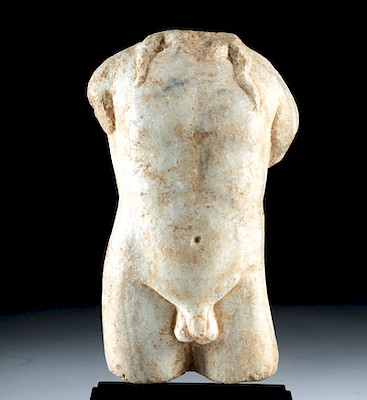Provincial Roman Marble Funerary Stele
Lot 42d
About Seller
Artemis Fine Arts
686 S Taylor Ave, Ste 106
Louisville, CO 80027
United States
Selling antiquities, ancient and ethnographic art online since 1993, Artemis Gallery specializes in Classical Antiquities (Egyptian, Greek, Roman, Near Eastern), Asian, Pre-Columbian, African / Tribal / Oceanographic art. Our extensive inventory includes pottery, stone, metal, wood, glass and textil...Read more
Estimate:
$9,000 - $14,000
Absentee vs Live bid
Two ways to bid:
- Leave a max absentee bid and the platform will bid on your behalf up to your maximum bid during the live auction.
- Bid live during the auction and your bids will be submitted real-time to the auctioneer.
Bid Increments
| Price | Bid Increment |
|---|---|
| $0 | $25 |
| $300 | $50 |
| $1,000 | $100 |
| $2,000 | $250 |
| $5,000 | $500 |
| $10,000 | $1,000 |
| $20,000 | $2,500 |
| $50,000 | $5,000 |
| $100,000 | $10,000 |
| $200,000 | $20,000 |
About Auction
By Artemis Fine Arts
Dec 5, 2018
Set Reminder
2018-12-05 10:00:00
2018-12-05 10:00:00
America/New_York
Bidsquare
Bidsquare : DAY 1 | Classical Antiquities & Asian Art
https://www.bidsquare.com/auctions/artemis-gallery/day-1-classical-antiquities-asian-art-3698
Day 1 of an important 2-day auction featuring ancient and ethnographic art from around the world. Egyptian, Greek, Roman, Viking, Near Eastern plus Asian Art from China, Japan, Thailand, Vietnam, Burma, India, more. Artemis Fine Arts info@artemisfinearts.com
Day 1 of an important 2-day auction featuring ancient and ethnographic art from around the world. Egyptian, Greek, Roman, Viking, Near Eastern plus Asian Art from China, Japan, Thailand, Vietnam, Burma, India, more. Artemis Fine Arts info@artemisfinearts.com
- Lot Description
Late Roman, Imperial Period, possibly Phrygian, ca. 3rd century CE. Skillfully carved from a single piece of white marble, a funerary stele or commemorative marker that depicts a family of three individuals - from left to right, two males and a female. All present similar expressions comprised of large open eyes with delineated pupils, thick lids, and arched brows, an aquiline nose, and gently smiling lips. Their facial planes are modeled so as to emphasize full cheeks, rounded chins, and arched foreheads. The males are presented with combed back coiffures and the female has a veil that curls at its lower ends so as to suggest breasts. Just who might this grave stele commemorate? Siblings? Cousins? We may never know. Nevertheless, it is a special example that marks the transition from naturalistic and idealized artistic expressions of the Classical World to the more symbolic visages that would be associated with the Middle Ages centuries later. Size: 21" W x 16" H (53.3 cm x 40.6 cm); 19" H (48.3 cm) on included custom stand.
Prior to the 2nd century, Romans cremated the deceased. But in time, inspired by the Greek and Etruscan practice of using sarcophagi, they began to place the deceased in sarcophagi. This practice spread rapidly throughout the Roman Empire. In the western part of the Empire, sarcophagi were placed inside a mausoleum against a wall or in a niche, so the only decorated panels were on the front and short sides.
Provenance: private East Coast, USA collection; ex-William Froelich Collection, New York, USA, 1960's
All items legal to buy/sell under U.S. Statute covering cultural patrimony Code 2600, CHAPTER 14, and are guaranteed to be as described or your money back.
A Certificate of Authenticity will accompany all winning bids.
We ship worldwide and handle all shipping in-house for your convenience.
#140286Losses to peripheries as shown. Abrasions to surface, especially to high pointed areas such as the noses, lips, and chins of the figures. Stable fissures at upper end. Iron rich stain over left-most bust and a few lighter stains here and there. Still, an overall very nice piece of funerary art.Condition
- Shipping Info
-
All shipping is handled in-house for your convenience. Your invoice from Artemis Gallery will include shipping calculation instructions. If in doubt, please inquire BEFORE bidding for estimated shipping costs for individual items.
-
- Buyer's Premium



 EUR
EUR CAD
CAD AUD
AUD GBP
GBP MXN
MXN HKD
HKD CNY
CNY MYR
MYR SEK
SEK SGD
SGD CHF
CHF THB
THB














